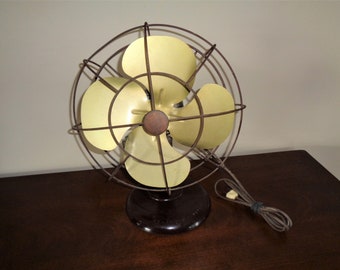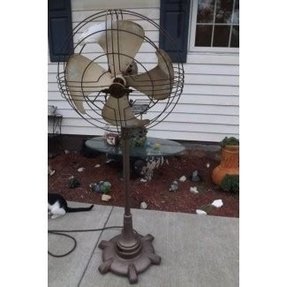- Antique Ge Oscillating Fan
- Antique Ge Fan Identification Manual
- Vintage Ge Fan Identification
- Antique Ge Fan Identification Parts

Welp, I did it again guys!
I restored another old fan! ...and to those following me on twitter, this is old news (but I took new and better pictures, so look below!)... But for those who don't follow me, all you watchers out there, I wanna show you a little project I took on for myself a few weeks ago~ <3
A 1901 General Electric fan (note the brass cage) - Image: eBay. However, manufacturers were forced to switch to steel as global reserves were co-opted for the war effort. After the war most never switched back. Initially fans were mainly produced in a stark black, with the notable exception of General Electric – which used green. If you have an old fan that still runs but looks bad, give us a try! Just take a look at our restorations on the site to see what we can do.We also have a large inventory of unrestored Antique and Vintage fans and Parts from 1906 thru the 1980s.If there is a fan your looking for or part you need give try us!
- Locate the serial number tag of your GE appliance. The tag includes the model number and serial number of the unit and may be located in several places, depending on the appliance type. Refrigerator and microwave tags are typically on an inside wall. On other appliances, check door edges, the back of the unit or inside the door opening.
- The fan did come with a guard which was an S wire guard with the GE badge in the middle. Your fan has an older incorrect GE Whiz blade and would have had a deeply pitched 3 wing blade that was polished aluminum. That fan is gonna take a lot of time and effort to get it back to normal and is essentially a parts fan.
The Story
So, I went to an antique store a few months back and noticed a little GE Vortalex fan form the 40s. Here's the thing, I've always thought the Vortalex fans were neat. The blades, the body design, all of it. But this fan was in pretty rough shape. The cage was completely rusted, the blades would hardly budge, it was missing the nut on the oscillation arm. On top of that, when I plugged it in, it only worked on one speed. I decided not to get it...but...it was on my mind for weeks after...still. A few weeks later, the week before FWA, I was out in that area again. I decided I wanted to see the fan again and have another look. It was still there. I expressed my concerns to the kind, old ladies who owned the store. I told them I restored them, which really excited them. I showed them my past work, and they gave me an offer I couldn't refuse on the Vortalex. And I took it home!
This is what it looked like when I got it~
http://i.imgur.com/k3nOi6r.jpg
Suspecting the speed issues might have come from debris and horrible lubrication for decades, I dropped a little bit of oil in. Turns out, I was correct. It was barely moving on Low speed, but it worked! However, the oscillating was another story entirely. When I took the fan apart and got the grease out of the gearbox, I found the oscillating gear's teeth were completely destroyed. That meant it needed a new part...which, on a 70 year old fan, would be a little tough to obtain.
Regardless, I went ahead. At least everything else worked, right? I sanded and stripped the paint off, got all the rust off all the way to a silky-smooth, metal surface. I busted out the black and brown tones for this one...since that's the color scheme of my bedroom. I chose a nice brown for the base and motor casing, a satin black for the cage, and a champagne color for the blades, finishing it all up with a black, braided cloth wire for a vintage feel. And lucky for me, I was able to locate an identical fan in an antique store last Monday, which I promptly bought and took the oscillating gear and arm nut from. The gear from that fan was in perfect condition, so I swapped them out.
After putting it all back together, it runs as smooth and as quiet as it was new...oscillating and everything. AND IT LOOKS SUPER AMAZING!!! I have to say, I'm so very proud of this fan...and I love it and cherish it for forever. Here's to another 70 years of service and beyond, GE Vortalex! <333
Here's some pictures for you all. Have a look! ^^
http://i.imgur.com/6PCev0b.jpg
http://i.imgur.com/WA7xmjN.jpg
http://i.imgur.com/8k6GSPP.jpg
http://i.imgur.com/ngaVMBP.jpg
http://i.imgur.com/zqHeVqc.jpg
http://i.imgur.com/ueXx3Oc.jpg
The electric fan was invented in the 1880s in the sweltering heat of the New Orleans summer.

Over the years the design was adapted and tweaked, with the first recognisably modern electric fans being produced in the 1920s.
They’re popular retro collectors items.
Here’s how to identify one.
Brand and model
Most electric fans will have a brand name displayed prominently in the centre of the cage.
This will immediately offer a clue as to its value, as certain “prestige” names are highly sought after.
Antique Ge Oscillating Fan
Examples include Veritys, which regularly sell for several thousand dollars.
The model's issue number will tell you exactly when it was made and give you an idea of its value.
You can check it on eBay or try the Antique Fan Collectors Association (AFCA) forums.
Size and shape
Up until the 1910s, most fans were large and unwieldy things designed for use in office spaces.
After 1910 the technology had advanced to the stage where fans were small and cheap enough to go in the home.
Materials
Prior to the first world war brass was the dominant material used in making cages.
However, manufacturers were forced to switch to steel as global reserves were co-opted for the war effort.
Antique Ge Fan Identification Manual
After the war most never switched back.
Colour
Initially fans were mainly produced in a stark black, with the notable exception of General Electric – which used green.
As fans became more widely available, designers began experimenting with different colours. So colour is a good indicator that your fan was produced from the 1930s onwards.
Keep an eye out for…
Vintage Ge Fan Identification
The Emerson Silver Swan: This 1930s design classic sells around the $300 mark in good condition.
Veritys Junior Orbit: If you have one of these in good condition, you’re looking at around $2,500.
Antique Ge Fan Identification Parts
General Electric: General Electric fans sell for anything from $60 to $1,000.